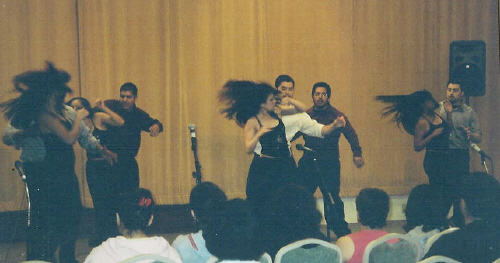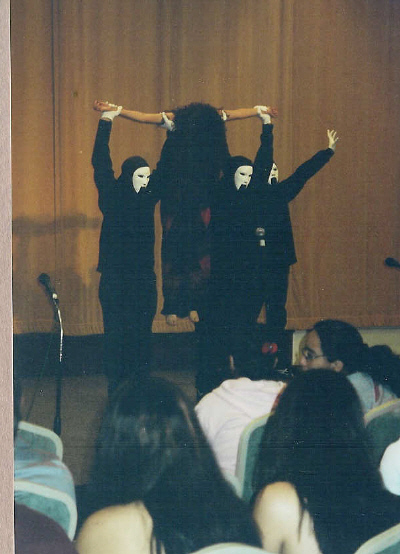| Posted: Mar. 07 2005,16:52 |
If you wrote this report, you will find a button here that you may click
in order to make changes in the report. 
|
PROGRESS: Has your organization seen
progress toward a culture of peace and nonviolence in your domain of
action and in your constituency during the first half of the Decade? |
We
"learned by doing" over the five Celebrations of the Art of Peace that
we have sponsored. The first year we had a contest with prizes,
but quickly found that that did not foster the spirit of cooperation
that a Culture of Peace requires. We dropped the prizes and have
since given certificates of appreciation to all the participants.
We
had individual and group performances at the first two Celebrations,
but have asked for only group creations for our last three. When
the youth work together to produce a "piece of peace" it seems to have
more of the elements of a Culture of Peace than do individuals working
and performing alone.
Finally, the discussion about violence that
closed our last Celebration which involved the youth and the audience
gave all a sense of what to do next in their schools and neighborhoods.
It put a positive ending to our Celebration that just finishing
the program of performances did not provide. We plan to keep
these discussions in future Celebrations.
|
OBSTACLES: What are the most important obstacles that have prevented progress?
|
It
was hard to find times when all of those students and teachers who
wanted to participate could come together for a Saturday morning.
As the schools see their arts budgets shrinking, fewer of them
can afford the transportation and other costs associated with being in
the Celebration. In 2005, it became impossible for the LA County
Department of Education to handle the mailing of our announcement to
the schools due to organizational changes and financial problems.
We are making our program more local in 2005, using neighborhood
councils to help with the funding and coordination and inviting some of
the schools that have already taken part to come back again and join
the participants from the neighborhoods.
Volunteer help is
always a "catch as catch can" situation. When we could afford the
coordinator in 2003 and 2004, it was less of a burden for the rest and
we more got done. We were never able, however, to go into the
schools as we would have liked to talk to the students about the
Culture of Peace and its principles while they were planning their
"pieces of peace". Also we were not able to do the evaluation and
follow ons that we had planned.
Rising costs have also made it
impossible for us to have the 2005 Celebration videoed by the
Educational Channel for local broadcast.
Time and money are
becoming major obstacles in our program. We have not been
successful in getting more grants. As the schools and youth
groups also have less funding, they are less able to join us. We
have developed many good ideas for the expansion of our program, but
lack the resources to implement them. One of these ideas is to
evaluate the medium and long-term progress of the Celebrations in the
lives of the participants and the activities of their schools. We
have the skills to create and carry out these evaluations, but not the
funds.
|
ACTIONS: What actions have been
undertaken by your organization to promote a culture of peace and
nonviolence during the first half of the Decade?
|
DESCRIPTION
Objectives:
The performing arts can help us imagine a culture of peace -- a culture
in which people treat each other and the earth in ways that build trust
and hope for our future. The artistic talents of our youth can
bring their visions to others who also want a culture of peace.
Working in groups to create dances, songs, videos, skits or plays
stimulates their creative juices and leads to powerful "pieces of
peace." Cooperation and diversity are important to peace building
and to creating art. Working together on group creations can
preview what living in a culture of peace could be like.
Beneficiaries:
Each of the last five years, we have contacted all the high schools and
many youth groups in Los Angeles county, inviting them to take part in
our Celebrations of the Art of Peace. More than 20 different
schools and youth groups have appeared in the five Celebrations.
Hundreds of people have been in the audiences for these
performances and thousands more have seen the last two Celebrations on
local educational cable television.
Locations and Resources: The
Celebrations have been held in the Soka Gokkai (SGI) International
Friendship Center on four occasions and at the Bahai Center on the
other. Most of the work to put on these Celebrations has been
done by volunteers from the non-governmental organizations that are
part of the S. CA Regional Council of Organization with financial
contributions from some of those organizations. We had a two year
grant for $4000 from the Society for the Psychological Study of Social
Issues that allowed us to hire a part time coordinator for the
Celebrations in 2002 and 2003.
Results: In addition to the
artistic creations that came out of the Celebrations, many people were
made aware of the Decade of the Culture of Peace and signed the
Manifesto. Friendships were begun among students from different
schools and groups. A discussion at the 2004 program led by a
group of SGI youth who are part of the Victory Over Violence program
resulted in some new ideas about and means of working on problems that
are causing violence currently in the lives of our participants.

Multicultural dance by South Pasadena High School Dance Troop

Anti-drug drama presented by another high school dance troop.
|
ADVICE: What advice would you like to
give to the Secretary-General and the General Assembly to promote a
culture of peace and nonviolence during the second half of the Decade? |
|
PARTNERSHIPS: What partnerships and
networks does your organization participate in, thus strengthening the
global movement for a culture of peace? |
|
PLANS: What new engagements are
planned by your organization to promote a culture of peace and
nonviolence in the second half of the Decade (2005-2010)? |
We,
of course, already have the cooperation of some 20 UN NGOs in
sponsoring and putting on the Celebrations. We also have
developed relationships at the LA County Office of Education and at
Channel 36 in Los Angeles. We are now making friends at two of
the Los Angeles Neighborhood Councils. We want to maintain these
connections. We would like to carry on our Celebrations until the
end of the International Decade for a Culture of Peace and
Non-Violence for the Children of the World in 2010, but will need more
imagination and hopefully more support from all our partners in future
years. Perhaps we can request some support through the UNESCO
website on the International Decade.
|
Postal address of organization
|
Southern California Regional Council of Organizations
c/o Dr. Paul Kimmel
1817 N. Fuller Ave. #204, LA, CA 90046
|
E-mail address of organization
|
|
Website address of organization
|
|
Highest priority action domain of a culture of peace
|
All of the eight keys to a culture of peace were important
|
Second priority action domain of a culture of peace
|
|
Highest priority country of action (or international)
|
United States
|
Second priority country of action (or international)
|
|
| Back to top |
|





